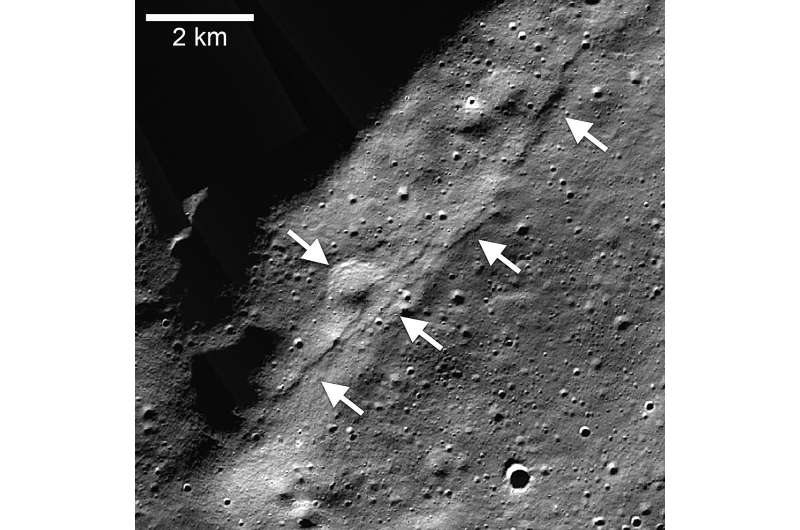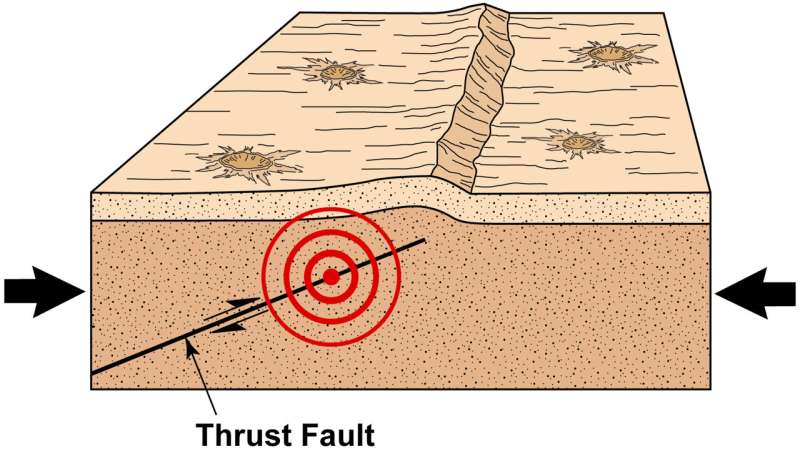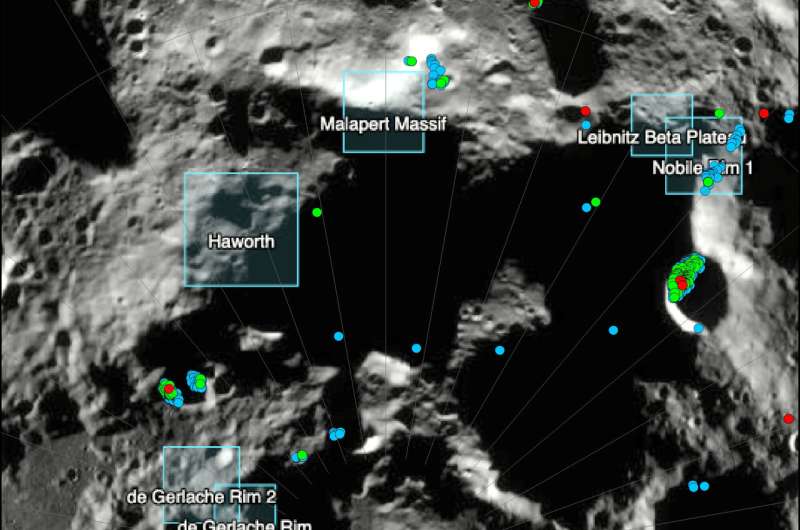Earth’s moon shrank more than 150 feet in circumference as its core gradually cooled over the last few hundred million years. In much the same way a grape wrinkles when it shrinks down to a raisin, the moon also develops creases as it shrinks. But unlike the flexible skin on a grape, the moon’s surface is brittle, causing faults to form where sections of crust push against one another.
A team of scientists discovered evidence that this continuing shrinkage of the moon led to notable surface warping in its south polar region—including areas that NASA proposed for crewed Artemis III landings. Because fault formation caused by the moon’s shrinking is often accompanied by seismic activity like moonquakes, locations near or within such fault zones could pose dangers to future human exploration efforts.
In a paper published in The Planetary Science Journal, the team linked a group of faults located in the moon’s south polar region to one of the most powerful moonquakes recorded by Apollo seismometers over 50 years ago. Using models to simulate the stability of surface slopes in the region, the team found that some areas were particularly vulnerable to landslides from seismic shaking.
“Our modeling suggests that shallow moonquakes capable of producing strong ground shaking in the south polar region are possible from slip events on existing faults or the formation of new thrust faults,” said the study’s lead author Thomas R. Watters, a senior scientist emeritus in the National Air and Space Museum’s Center for Earth and Planetary Studies.
“The global distribution of young thrust faults, their potential to be active and the potential to form new thrust faults from ongoing global contraction should be considered when planning the location and stability of permanent outposts on the moon.”
Shallow moonquakes occur near the surface of the moon, just a hundred or so miles deep into the crust. Similar to earthquakes, shallow moonquakes are caused by faults in the moon’s interior and can be strong enough to damage buildings, equipment and other human-made structures.
But unlike earthquakes, which tend to last only a few seconds or minutes, shallow moonquakes can last for hours and even a whole afternoon—like the magnitude 5 moonquake recorded by the Apollo Passive Seismic Network in the 1970s, which the research team connected to a group of faults detected by the Lunar Reconnaissance Orbiter more recently.

Lunar Reconnaissance Orbiter Camera (LROC), Narrow Angle Camera (NAC) mosaic of the Wiechert cluster of lobate scarps (left pointing arrows) near the lunar south pole. A thrust fault scarp cut across an approximately 1-kilometer (0.6-mile) diameter degraded crater (right-pointing arrow). © NASA/LRO/LROC/ASU/Smithsonian Institution
According to Nicholas Schmerr, a co-author of the paper and an associate professor of geology at the University of Maryland, this means that shallow moonquakes can devastate hypothetical human settlements on the moon.
“You can think of the moon’s surface as being dry, grounded gravel and dust. Over billions of years, the surface has been hit by asteroids and comets, with the resulting angular fragments constantly getting ejected from the impacts,” Schmerr explained.
“As a result, the reworked surface material can be micron-sized to boulder-sized, but all very loosely consolidated. Loose sediments make it very possible for shaking and landslides to occur.”

The lobate scarps are formed when the lunar crust is pushed together as the Moon contracts. This causes the near-surface materials to break forming a thrust fault. The thrust fault carries crustal materials up and sometimes over adjacent crustal materials. Slip events on existing faults or the formation of new thrust faults trigger shallow moonquakes that can cause strong seismic shaking tens of miles (many tens of kilometers) away from the scarp. © Arizona State University/Smithsonian
The researchers continue to map out the moon and its seismic activity, hoping to identify more locations that may be dangerous for human exploration. NASA’s Artemis missions, which are set to launch their first crewed flight in late 2024, ultimately hope to establish a long-term presence on the moon and eventually learn to live and work on another world through moon-based observatories, outposts and settlements.

Image shows predicted areas of surface slope instability in the south polar region. Models are for a one-meter-thick (about 3.3-foot) regolith landslide. Blue dots are areas with the least unstable slopes, green dots are moderately unstable slopes, and red dots are most unstable slopes. Image centered on Shackleton crater and the lunar south pole. Locations of proposed Artemis III landing regions are shown by the blue boxes. The model predicts large portions of the interior walls of Shackleton crater are suspectable to landslides (inset) as well as portions of interior crater walls in the Nobile Rim 1 landing region. © NASA/LROC/ASU/Smithsonian Institution
“As we get closer to the crewed Artemis mission’s launch date, it’s important to keep our astronauts, our equipment and infrastructure as safe as possible,” Schmerr said.
“This work is helping us prepare for what awaits us on the moon—whether that’s engineering structures that can better withstand lunar seismic activity or protecting people from really dangerous zones.”
More information:
Watters et al, Tectonics and Seismicity of the Lunar South Polar Region, The Planetary Science Journal (2024). DOI: 10.3847/PSJ/ad1332
Provided by
University of Maryland
Citation:
Scientists discover the moon is shrinking, causing landslides and instability in lunar south pole (2024, January 25)



